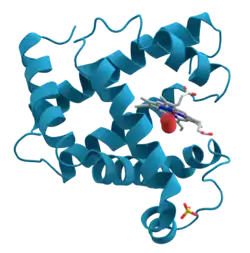Biomolecule
A biomolecule is any molecule produced by a living organism. That includes large macromolecules such as proteins, polysaccharides, lipids, and nucleic acids, as well as many smaller molecules.

Biomolecules are used in biological processes such as cell division, morphogenesis, or development.[1]
Just four elements—oxygen, carbon, hydrogen, and nitrogen—make up 96% of the human body's mass. But many other elements, such as the various biometals, are also present in small (but vital) amounts.[2]
Biometals are at the heart of many biomolecules. One or two atoms of copper, zinc, iron or manganese are in the most important biological molecules.[3][4] They act as cofactors, electron donors, at the heart of key biological molecules.
Types of biomolecules
A huge range of biomolecules exist, including:
- Small molecules:
- Lipids, polysaccharides, glycolipids, sterols, glycerolipids
- Vitamins
- Hormones, neurotransmitters
- Metabolites
- Monomers, oligomers and polymers:
| Biomonomers | Bio-oligomers | Biopolymers | Covalent bond name between monomers |
|---|---|---|---|
| Amino acids | Oligopeptides | Polypeptides, proteins (hemoglobin...) | Peptide bond |
| Monosaccharides | Oligosaccharides | Polysaccharides (cellulose...) | Glycosidic bond |
| Nucleotides | Oligonucleotides | Polynucleotides, nucleic acids (DNA, RNA) | Phosphodiester bond |
References
- Bunge M. 1979. Treatise on Basic Philosophy, vol. 4. Ontology II: A World of Systems, p. 61-2. link.
- Alberts B, Johnson A, Lewis J, Raff M, Roberts K, Wlater P 2002. Molecular biology of the cell (4th ed). New York: Garland Science. pp. 120–1. ISBN 0-8153-3218-1
- Maret W 2018. (Arruda MA, ed). Metallomics: the science of biometals and biometalloids. Advances in Experimental Medicine and Biology. Springer International. 1055: 1–20. doi:10.1007/978-3-319-90143-5_1. ISBN 978-3-319-90143-5. PMID 29884959.
- Banci L ed. 2013. Metallomics and the cell. Dordrecht: Springer. ISBN 978-94-007-5560-4